Thailand
Leaving Nepal on March 1, we had a crash course in different
types of airport security. Kathmandu's airport is not considered "secure" so we had to go through some gymnastics. Inside, the checkpoint
to get into the departure area was chaotic.
Agents ignored alarms going off, people walked back and forth around the
metal detectors, and the person watching the X-ray machine was very busy
visiting with friends as luggage flew through the machine.
It was almost a relief, at first, to queue up in another security line
that seemed to be administered by the Indian government. There, women were separated from men and the
line was again crazy with the guards seemingly clueless as to how to move
people through. Women were checked more
thoroughly than men. I had to wait a
long time for Jenny and Kate. India is very serious about security due to threats from Pakistan-based terrorists and internal secessionist groups.
We moved on to yet another checkpoint on the tarmac at the foot of the
stairs onto the Air India plane. We were
separated once again into lines for men and women, both of which fed into a
narrow covered wagon-like vehicle that was pulled up in front of the
stairs. There was a lot of officious
stamping of boarding passes and luggage tags, all of which had been stamped several times already. Finally we
got aboard and found our seats.
Our flight to Thailand went by way of New Delhi. Since we switched airlines there, we had to
get our bags and re-enter through yet more checkpoints. Amid
all the stamping of passports, boarding passes and luggage tags I didn’t notice
that one fellow had stamped my boarding pass for Bangkok as “domestic” India security
clearance. He made the same mistake on a
lot of other people’s boarding passes. A
big crowd built up around the door of the plane as the gate personnel refused
to allow us to board.
An equal-sized crowd of excited security officials
gathered, shouting. They jostled one another, examining and re-examining the passes. Furious
phone calls were made. The
crowd of people with the wrong stamp grew larger. More officials arrived. Indian passengers began to berate the officials while
waving their passes. Jenny and Kate were already on the plane. I quietly asked a crew member if they could
come back, because we needed to stay together.
What? What? More phone calls, shouting among the
officials, and then suddenly they melted away with no explanation or instructions. After a bewildered pause we asked the airline
crew if it was okay to board. Yes of
course! they answered, pretending nothing odd had happened.
Weird.
We didn’t know what to expect in Bangkok. Would it be like Delhi? I thought I might burst into tears if it
was. When we landed and hesitantly exited
the aircraft, sniffing the air and our eyes darting left and right, we were
shocked: the airport was immaculate and ultra-modern. A lot of flights arrived at the same time as
ours, so there was a massive backup at immigration. The Thais laughingly handled everyone very
efficiently and we were on our way.
Outside we weren’t assaulted by a mob of touts and porters. I started to relax. Our only hitch was that our first taxi
driver’s car wouldn’t start. Once on our
way we were dazzled by lanes on the highway and people staying in them! Kate piped up from the back seat, “What’s
that strange clicking sound? Oh my god, he’s using turn signals!” We flew along into the city on a paved road
devoid of throngs of pedestrians, tractors, cattle, goats, scooters, and people
driving the wrong way against traffic.
 |
| Detail on a stupa |
 |
| At the entrance to the royal palace complex |
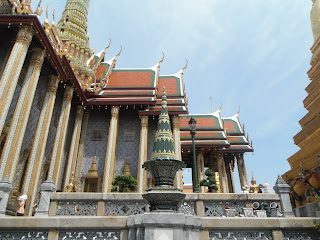 |
| We loved the Thai aesthetic |
Wow. Bangkok was
fully modern. And, we realized, a lot
less interesting because of that. Jenny
had found a smokin’ hotel deal at the Anantara Sathorn. We were dazzled to be ushered into a huge
room that was really an apartment. It had
two bedrooms, two baths, a living room and huge kitchen. The hotel was the perfect place for us to
regroup from India and Nepal.
 |
| In the thick of the tourist swarm... |
Man was it hot. And
humid. We went on a trek to see the
Royal Palace by way of the squeaky-clean elevated train and crazy river
buses. On the boats, the drivers seemed
to feel they could dispense with tying up by ramming into the docks and letting
the stern wave hold the boat while people flung themselves on and off. It was pretty wild. The Thais were blasé while we hung on for our
lives. The river was jammed with all
kinds of boats zooming around. When we
got to the Royal Palace stop we were already soaked with sweat.
 |
| We liked the combination of East and West in the palace |
The palace compound was full of beautiful buildings covered
with gold, mirrored tiles, and swarms of tourists. We hadn’t seen the Swarm since we left
Istanbul. The grounds were jammed. We had wanted to see the Emerald Buddha
(really jade), above all else. So we braved
our way to its magnificent temple to grab a tiny spot on the floor for a few
minutes of contemplation. Emerald Buddha
sat in a glass case at the apex of what can only be described as an elaborate
20-foot high heap of treasure. The building around
us was a riot of exquisite carving, inlays and gorgeous fabrics. The real Buddha would probably have been
bemused by the display.
The heat drove us back to the hotel. We spent a couple days lazing around the
pool, doing a little shopping, shipping stuff home and eating fantastic Thai
food. It was an excellent way to rest up
from our adventures over the previous six weeks.
Cambodia (from another of Jenny’s letters)
We flew into Siem Reap, Cambodia from Bangkok on March 7th. Siem Reap
lies in the central NW part of Cambodia and has landed on the world map of
places one must visit if one is well-traveled. Why? Siem Reap is home to
the famous and impressive Angkor Wat temple and a multitude of other smaller
but equally intriguing temples all built between the 9th and 14th century.
The Temples are a mix of Hindu, Buddhist and indigenous ancestor cult
influences. Angkor Wat is, by far, the largest and is remarkably intact
given the horrendous wars fought on this land, heavy tourist use and jungle that
relentlessly encroaches on all man-made objects - and usually wins.
Additionally, the town of Siem Reap bustles with a French flair that is
very visitor-friendly. The surrounding countryside
is lovely.
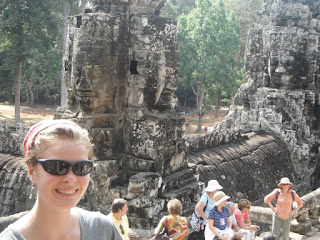 |
| Bayon Wat |
 |
| Bayon Wat |
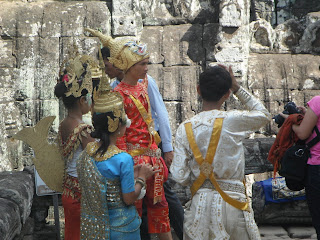 |
| Cambodian kids in traditional costume |
 |
| One of the hundreds of faces at Bayon Wat |
 |
| Still smiling in some serious jungle heat! |
 |
| At Bayon Wat |
We spent a total of six days taking in the sights and enduring the astounding
heat. It made summer in D.C. seem chilly.
Even the locals commented on the heat wave. This was not good. So we had to grin and bear it and learn to
embrace the sweat. We stayed at the Soria Moria. This lovely
hotel, one of Lonely Planet's top picks, was fantastic. It was located
just on the edge of downtown, owned by a lovely Norwegian couple and run by
some supremely fine Cambodian people. The
hotel actively supported local tradespeople and truly practiced green lodging
methods. So many places say they do, but don't. We had a comfy room
with great a/c, thank God! and a delicious breakfast every morning. The
service was important because Doug was quite sick the entire time we were there.
More on that later.
A visit to Angkor can be a bit daunting as the area is vast and there are more
sites than you could visit in a month.
The temples used to be surrounded by a huge city. All the wooden buildings from that time have
decayed back into the forest, leaving only the temples. You can buy a three day pass which gets you
into virtually all the major sites. It’s
plenty of time in which to get a good sense of the differences among the
temples and to see the surrounding countryside.
 |
| One of the active shrines among the ruins |
 |
| Note that the arch had not been invented or introduced here by the 8th-12th centuries |
 |
| Fabulous reliefs were everywhere |
Transport comes in a number of forms: bicycles, tuk-tuks, private cars or tour buses.
On our first day we decided to bike. We rented some very rickety
old bikes and headed out into the heat, hoping a leisurely pace and the breeze
created by our forward movement would keep us from expiring in the heat. We
rode six kms or so along a flat road lined with trees and monkeys. In
normal temperatures it would have been very pleasant but with the mercury hovering over 100F and humidity at about 95%, we were fools.
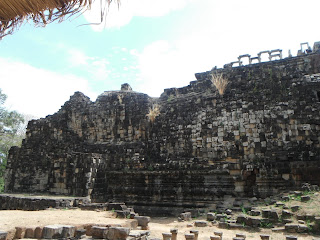 |
| Head and shoulders of a reclining Buddha that was never completed, Bap Huon |
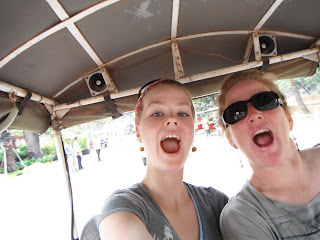 |
| Dad's sick - let's party in a tuk-tuk |
We pedaled past Angkor Wat to Bayon Wat, also known as
the Temple of Faces. It was extraordinary. From every angle you
could see fantastically carved exotic faces of Jayavarman VII, the king who
built the temple in the late 12th century. It was all very surreal when
added to the otherworldliness of the Cambodian jungle.
We pedaled on to Bap Huon, a most unfortunate temple. Seems the French had completely dismantled
the structure at the time the Vietnam war heated up. They had carefully mapped and numbered every
block of stone but they hadn’t planned to be absent for decades. When they returned they confronted an
overgrown pile of over 300,000 blocks of stone that had been severely disrupted
by the fighting. Many of the plans had been lost. Amazingly, they pieced
it all together.
When we exited at the
rear, we saw a further complication. Back in the 12th century, the
ancient Khmer had begun taking blocks from the temple to construct an enormous
reclining Buddha. The French
archaeologists had to piece this together as well. We passed through some gates that were
covered with ficus roots, creating a spooky atmosphere.
We clambered around the ruins for about two hours before the
heat really got to us. Doug was really suffering. Kate and I escorted him back to the hotel as
he wasn't sure he could make it. He was getting
sick.
Over the next five days Kate and I explored the area while
Doug stayed in the hotel room. Our favorite mode of transportation
was a tuktuk. Tuktuks are like rickshaws but are pulled by a small
motorcycle or scooter. They are really fun because they’re exotic and you
are out in the elements. One day we headed out for the whole day into the
countryside to see a small pink sandstone temple called Bantrey Srey, hike
in the jungle, and to see the Cambodian Land Mine Museum.
 |
| Cambodian countryside |
 |
| Countryside |
Cruising along in the Cambodian countryside was great.
We got far enough away from Siem Reap and the whole Angkor Wat complex to
get a feel for rural Cambodia. It was very beautiful and peaceful.
Small one-room huts elevated on stilts lined the roadside in small
communities between rice paddies and sections of jungle. The communities
usually had one or two communal wells and each home had a domed clay oven out
front.
The areas under the houses were used for cool living space in the
heat of the day. You could see hammocks strung up between the stilts and
many were in use. The communities were busy and clean. People
smiled and waved as we scooted by. One truck filled with young male teens sped
past us. As they went by one of the happy young men took pictures of Kate.
Kate, in a friendly and playful way, shook her head and wagged her
finger. He laughed, so did she, and off sped the truck.
 |
| Bantrey Srey |
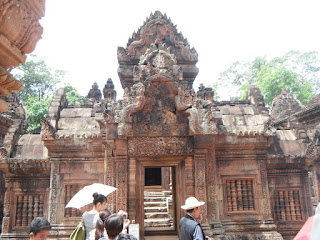 |
| Bantrey Srey |
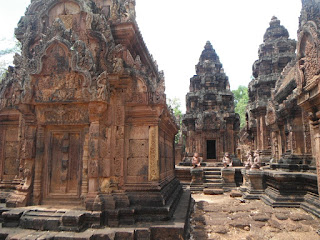 |
| Bantrey Srey |
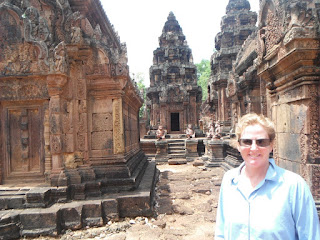 |
| Bantrey Srey |
 |
| Bantrey Srey |
 |
| Bantrey Srey |
 |
| Bantrey Srey |
Bantrey Srey is very beautiful. It is famous for its pink sandstone and extremely
fine and intricate carvings. It looks very delicate. Legend holds that
only women could have built it because of the fine carvings. Additionally,
it is small and tucked away in the jungle off the beaten path. We
wandered around the temple feeling very lucky to be seeing such a
beautiful work of art. The temples are other-worldly. As Westerners
we don't have a frame of reference for the architecture or the culture that
built them. We did our best and just enjoyed them for their exotic
beauty. The heat was intense so we ended up not staying at the temple too
long. We headed up the road another 20
km for a hike to see a jungle river with ancient Hindu carvings in the riverbed.
 |
| Kate with river carvings |



At first we were concerned about the hike as we only had our flip-flops. It was described as moderately difficult, about
2 km with an elevation gain of 1500 meters. At the trail head we met a returning
American hiker. He looked extremely sweaty and exhausted. He cautioned us on the extreme conditions of
the hike and hoped we were ready. Not to be wimps we forged on, a wee bit
nervous about what lay ahead. Did I also mention how HOT it was? So
we ascended in our flip-flops, bracing ourselves for the massive climb.
It never came. There were signs marking each 100 meters
accomplished and all of a sudden we were at our goal: The River of One Thousand Lingas!
Frankly, I would liken it to a lovely stroll through the jungle, not a
hike. We scratched our heads, wiped the sweat off our brows and gazed out
on the ancient Hindu carvings of Shiva on the bedrock and the thousands of
Lingas. Lingas are ancient Hindu phallic symbols that represent
regenerative powers. They look like slightly raised knobs. There
were thousands of them all along the river bed. It was kind of cool
thinking of the work that went in to this whimsical project so many years ago.
Aside from the riverbed carvings, the jungle itself was really interesting.
It was very steamy and incredibly noisy! Cicada-like bugs were
deafening. The dense foliage was a little creepy as our eyes couldn't penetrate
much beyond six feet. It made me think about the American soldiers in the
Vietnam War and the harsh, completely different environment they were thrown
into. It gave me a tiny glimpse into what it must have been like, sans
the fear, mayhem, fatigue, hunger, etc., etc.
When we finished our hike we stepped into the parking lot. It was jammed with tuk tuks, private cars and
tiny open-air restaurants. Since we were hungry, we began to turn their
way. At first everything was quiet. Then a cacophony erupted. Women yelled, "Madam, you hungry, you
eat here! Good price!"
I love the people in the developing countries we visited, but I hate their sales techniques.
I won't miss this about many of the countries we have been through.
We finally chose a food stall that our tuktuk driver pointed to. He probably got a commission for sending us to
that one. Fine. We were starving. After filling our bellies
with chicken satays, peanut sauce and rice we jumped back into the tuktuk and
rattled off to the Cambodian Land Mine Museum (CLMM).
 |
| Mine collection at CLMM |
According to the information at the CLMM, there are still an estimated five to
six million unexploded mines, bombs and shells imbedded in the Cambodian
countryside. This astounding and
horrific number of devices remains even after extensive efforts to clear them by
government and private organizations such as the CLMM. Sadly, most are
found by farmers plowing or children playing outside. Not all explode. Many do.
They kill, maim or leave awful scars on men, women and children. They create many orphans. Dotting the
countryside are signs warning passersby not to leave the trails, or more
directly, “Danger, Do Not Enter." These signs are serious and one
should take heed as real danger lies beyond.
So where did these lovely killers come from? The
United States is responsible for a large portion of them. In our attempt
to stop the Viet Cong from using the Ho Chi Minh Trail we bombed the Trail,
which ran along the border of SW Vietnam and SE Cambodia. Given that
carpet bombing is not an exact science and many bombs do not explode on impact,
many of the bombs landed unexploded well into Cambodia. Later, the infamous
Khmer Rouge, under Pol Pot, placed millions of land mines all over the country,
particularly in the NW region where we were, to control the movement of their
own people and to repel the invading Vietnamese Army.
The CLMM is a small museum/orphanage dedicated to educating the public about
the issue of land mines in Cambodia and to providing a home for about 24 children
who have been orphaned or maimed by land mines.
The museum is full of information about the Pol Pot regime and examples
of all the different kinds of ordnance still out there. We saw metal
discs that are buried just under the soil and are pressure sensitive, numerous
trip-wire beauties where you can barely see the wire attached to two mines on
either side of the trail, hanging bombs triggered by trip wires, and random
unexploded ordnance lying in wait.
Though it seemed impossible, the heat was worse in Phnom Penh. Thankfully we had a
beautiful room with great air conditioning so Doug could rest. My final
diagnosis was a double-header of viral bronchitis and Giardia. While in
Siem Reap he had developed a nasty cough with severe body aches and a 101
fever. His fatigue was profound. At first I thought it was
influenza but, unlike the flu, it came on slowly and departed slowly. In
Siem Reap I had almost taken him to the hospital. After talking to the incredibly helpful owner
of the hotel, however, and running through all the possible tropical diseases
floating around out there, I had decided to wait and see.
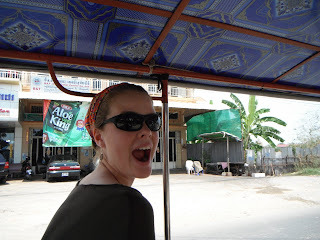 |
| Some Cambodia street scenes |
By the time we got to Phnom Penh Doug’s cough and fever were
subsiding but his digestive symptoms were worsening and the fatigue persisted.
So I decided to deploy the big guns. I went out in search of a
pharmacy and purchased Tinidazole, a great drug for Giardia that is one dose of
4 tablets. The best part was that a package of 10 tablets only cost one dollar!
In the US it would have been $50.00.
We joked that a hot dog bun bakery must have designed the packaging –
why would you sell 10 when each dose was 4 tablets?
I researched the manufacturer to make the drugs were legit,
then had Doug choke them down. Next morning we flew to Bangkok. He
was still marginal but better. In the Bangkok airport the recovery
accelerated to the point where he stepped onto a moving sidewalk still feeling
crappy and stepped off the other end feeling great. It was that quick.
I could see a visible difference in him. He has felt great since but
is disappointed that he missed all of Cambodia. We’ll have to go back.
On our day in Phnom Penh, Kate and I went to Choeung Ek, one
of two Killing Fields in Cambodia. I don’t mean the movie set. I mean the actual field where the Khmer
Rouge, under Pol Pot, executed nearly ten thousand Cambodian political
prisoners, civilians and some foreigners during the height of the Khmer Rouge reign
from 1975 - 1979. See
http://en.wikipedia.org/wiki/Killing_Fields.
Today it is a peaceful memorial park where one can learn about the
atrocities and appreciate the extraordinary ability of the Cambodian people to
move on.
We walked quietly with our audio guide headsets on,
listening to an incredibly moving program about what happened. At times
you could see human bone sticking up through the ground. The bones
regularly appear due to movements of soil.
Staff place all of the bones in a huge Buddhist stupa that sits in the
center of the field in memory of all who died here. We saw the
mounds of undisturbed mass graves and pits of graves that had been excavated.
Some of the other exhibits are difficult to describe and very disturbing,
so I will leave it at that. The Killing Field is relatively small given
the enormity of the crime committed here. The Genocide Museum is also in
the park. It houses photos of all who
were taken by the Khmer Rouge, both before and after they were executed.
We figured that display was more than we could bear to see. For
some reason the Pol Pot regime kept meticulous records and photos of each of
their victims.
Needless to say, it was a sobering day. I had never really understood how
bad it had gotten in Cambodia. In 1975, when Pol Pot gained power, he
swept into Phnom Penh and within an astonishing 48 hours had cleared the city
by sending everyone back to their ancestral villages. This created chaos
and disrupted any possible resistance.
Anyone who didn't have any connection to a rural village was identified
as a likely intellectual and killed immediately. Anyone who resisted was killed on the spot. During
the Pol Pot regime an estimated 2.2 to 3 million Cambodian people were killed
out of a population of 8 million. The majority were killed between 1975 and
1979.
From 1979 to the early 1990s the regime was still intact but
had lost a lot of power due to the utter collapse of the country and incursions
by the Vietnamese government. Despite the known atrocities, Pol Pot and
the Khmer Rouge were still recognized as the official government of Cambodia by
the UN. Finally, in 1990, after slowly retreating to the NW part of the
country, the Khmer Rouge was officially overthrown and a parliamentary
democracy emerged. Since then the country has been feverishly rebuilding
and successfully moving forward from its horrific episode. Democracy is
still fragile but seems to be holding.
Kate and I returned to our hotel by a tuktuk that took us through the dusty
streets. It was a long ride and we wished we had had scarves to cover our
faces. We were inhaling all sorts of
lovely airborne specks. Between the heat and the dust, by the time we got
back we felt like we’d been breaded. We
decided to forego further sightseeing and attend to Doug. So we lounged
in our air-conditioned room, watched TV and ordered take out. It was a great
way to end an emotional day.
We loved Cambodia despite only seeing a touristy sliver of the country.
It is beautiful, with remarkably gentle people. The older generation
is noticeably missing, but the younger generation is working hard to develop a
thriving country that can compete in the modern world and provide its people
with choices.
As we have traveled through some developing countries we have been challenged
to make peace with vast disparities in wealth and choice. The goal is not
to become Western with all the material trappings of a "successful"
life. That can be a curse. The
goal is simply that people have freedom to choose how they will live their
life. That freedom comes with clean water, healthy food, safe shelter,
education, a sense of the future and some voice in how one’s nation moves
towards that future. I guess that is all we can ask for.
Back to Thailand! (Doug’s narrative)
I was a little leery of the long travel day from Phnom Penh
to Bangkok and then on to Ko Lanta in southern Thailand.
I was still feeling pretty dumpy when we got in the car at the hotel in
Phnom Penh and made our way to the airport through the streets of the
city. The flight to Bangkok was fairly
short, thank goodness. In the midst of
the airport where we switched flights I suddenly felt 100% better. It was surprising. Jenny’s decision to nuke my stomach with
antibiotics seemed to be the right one.
I had, however, missed almost all of Cambodia.
When we landed in Phuket we switched to a car for the
five-hour drive to Ko Lanta, an island along the coast to the south. Thai roads in the area are quite good, and
so are the drivers. It would be a nice
area to bicycle. We didn’t get in to La
Laanta, our hideaway resort, until almost midnight and until we’d made two
ferry crossings. On March 17th
we woke to a gorgeous spot on a gorgeous beach.
The little resort is a group of cottages nestled among palms next to a
national park, quite apart from any hustle and bustle on other areas of the
island. It would be a perfect hangout
for the next couple of weeks.
Our routine was pretty simple for the most part: up whenever, hoping to get to breakfast
before it closed down at 10:30, down to the beach to read and swim, lunch,
maybe a nap, swim, drinks, dinner, hang out watching movies or reading,
bed. By the time we left we were getting
a little antsy so we knew we’d had a good rest.
Other pursuits included an elephant ride and jungle
hike. The elephants were very sweet and
gentle. The one Jenny and Kate rode was
a big bruiser with large tusks. Mine was
more mid-sized and very friendly.
Especially when you had some pineapple.
On the jungle hike we climbed through forest to a crater-like sinkhole
where the last tigers in the area had lived until about 4 years ago when they
were relocated to a preserve on the mainland.
On another day we took a long ride in a taxi to do a bit of shopping and
to get me a haircut. I thought I
explained that I wanted my beard trimmed, but the woman doing my hair shaved
the whole thing off. I didn’t have time
to stop her before she took the first swipe.
Oh well. Jenny and Kate got a big
laugh.
On the 29th we took reluctant leave of the fine lads
making up the staff of La Laanta and rode by van to the train station in Hat
Yai where we picked up a sleeper train headed south down the isthmus through
Malaysia to Singapore. The countryside
was very beautiful, especially the huge palm oil plantations along the
railway. The train was clean and
comfortable. We were excited to get to
Singapore because we’d heard a lot about it and because Kate would get to see
The Hunger Games movie in English.
Singapore
Singapore surprised us with its park-like setting, big trees
and immaculate landscaping along the boulevards. I scored points in our informal competition
to snag great places to stay when we were delivered to a fancy apartment in a
high-rise with nice views of the surrounding area. Our hosts had moved to another apartment and
were helping to pay for the remainder of the lease with sublets on Airbnb. We enjoyed the big lap pool and the ability
to walk everywhere.
As promised, we went to The Hunger Games on the 30th
after Jenny and Kate got haircuts.
Popcorn! We hadn’t seen it since
Ljubljana. What a luxury. The movie was worth waiting for. We were surprised by the behavior of the people
at the movie, who talked nonstop and checked their phones throughout.
On the day we left we visited with Laura Dodge and her
husband Dusty. They live in Singapore
while Dusty serves as part of the US Embassy staff. Jenny knew Laura from Camden Yacht Club days
of yore, when she taught Laura sailing.
Their three year-old son Finnegan was a busy lad and a good swimmer as
we hung out in the pool for the afternoon.
We enjoyed their perspective on the world (both have lived in Asia a
long time) and Dusty’s, well, diplomatic descriptions of what life is like at
an embassy. They gave us a lot of
encouragement to consider living abroad.
Later that evening we hopped into a taxi and caught an
overnight flight to Darwin, Australia where we had a few hours’ layover until
our plane for Alice Springs took off.





















